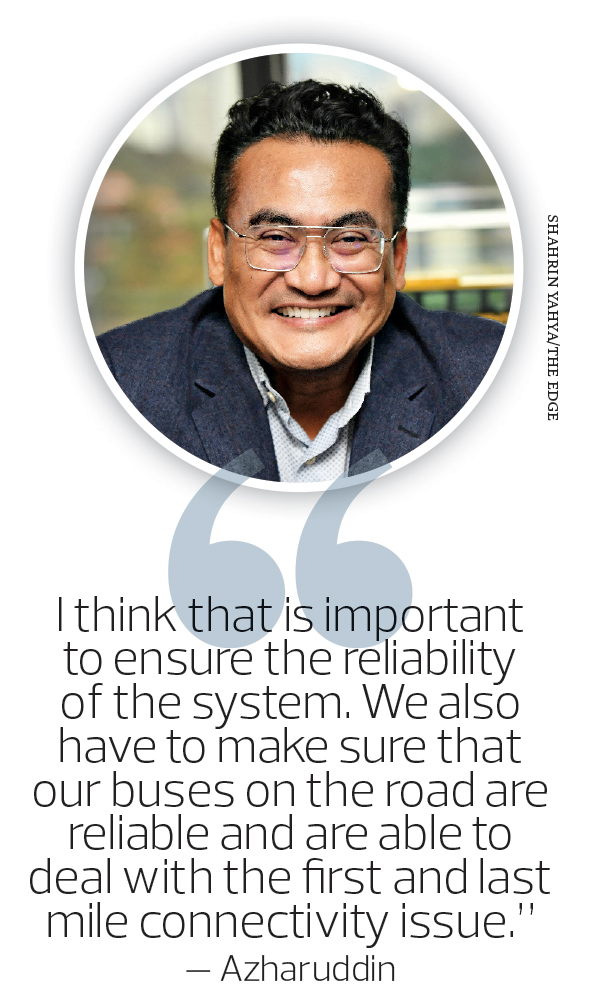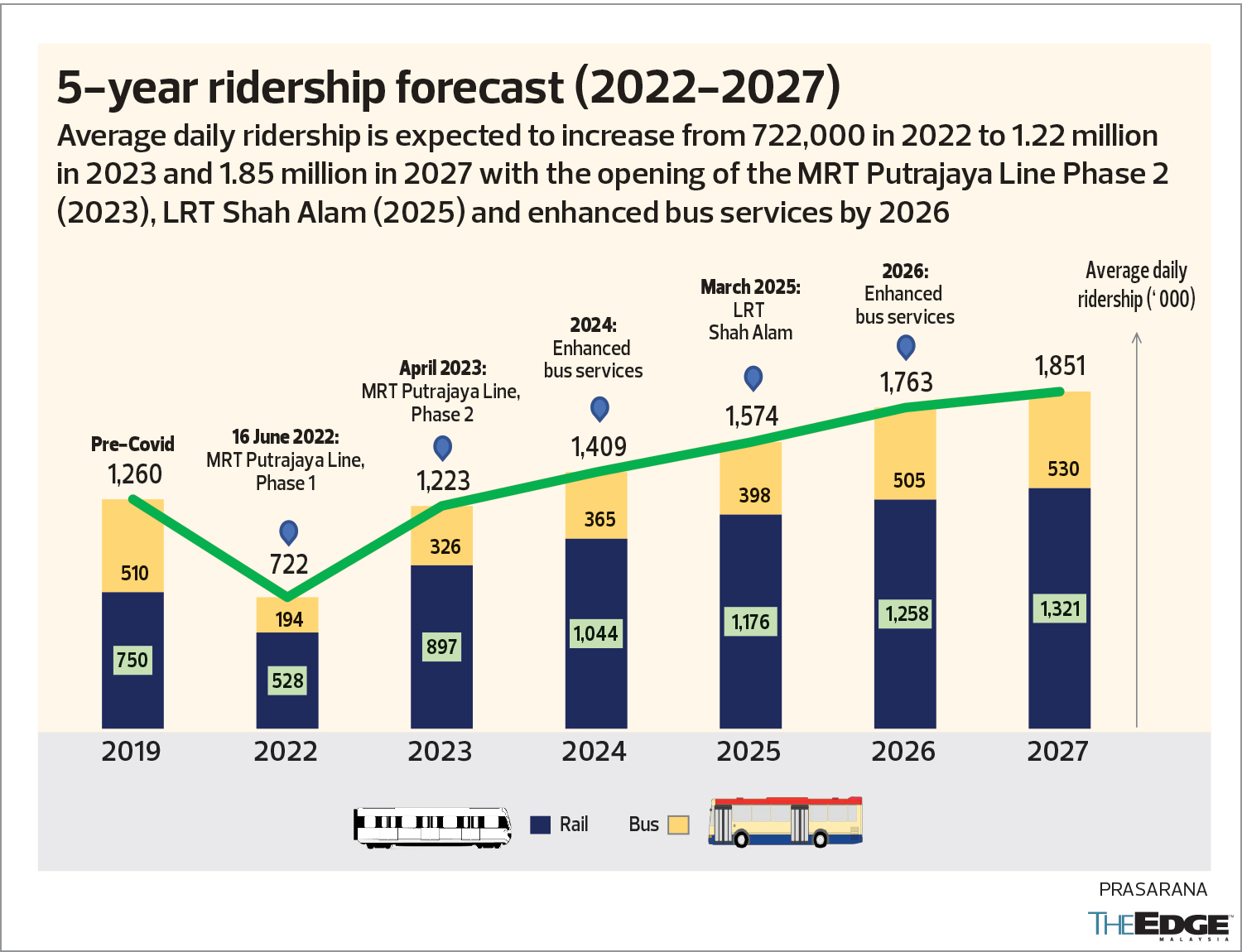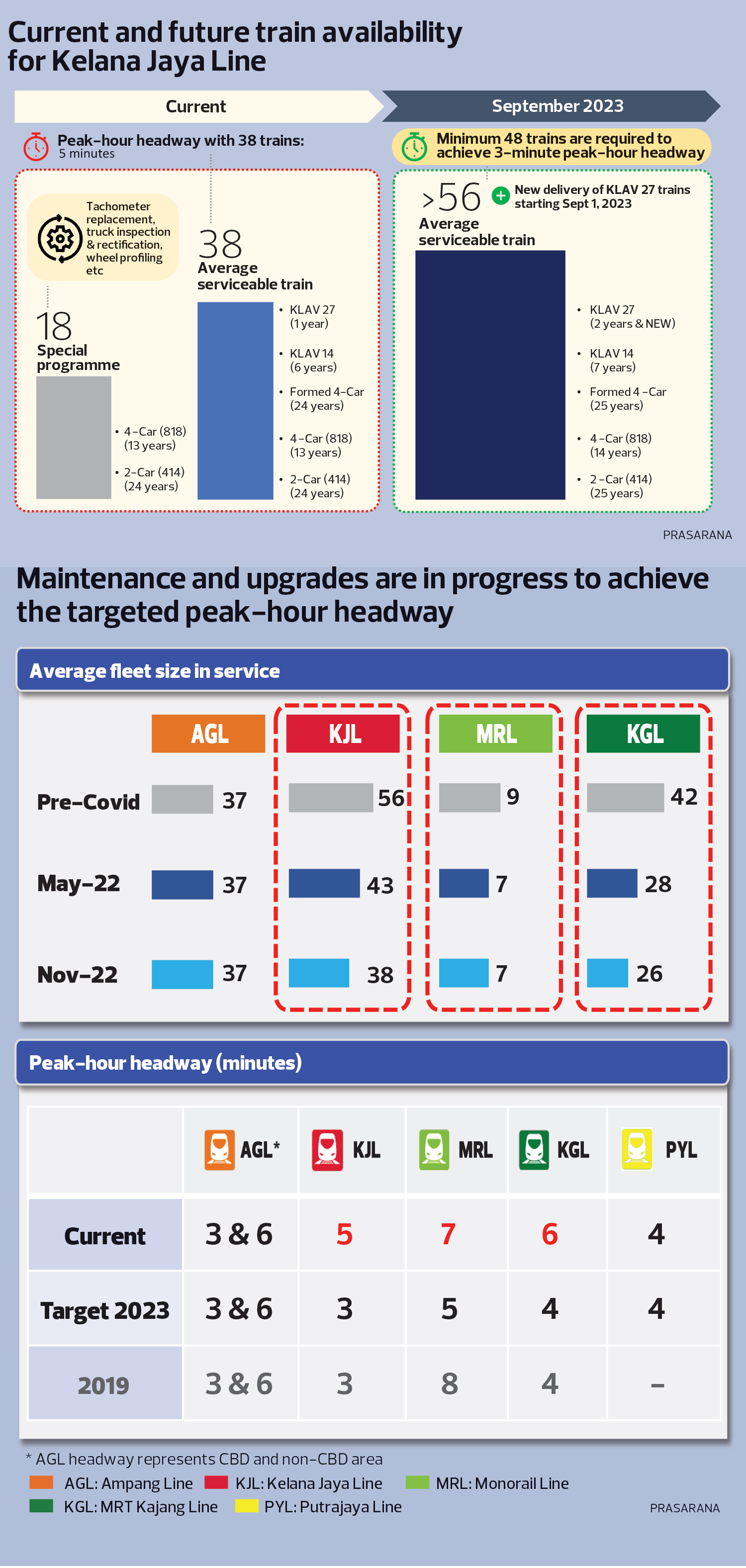
This article first appeared in The Edge Malaysia Weekly on January 30, 2023 - February 5, 2023
MOHD Azharuddin Mat Sah has been in the line of fire since taking over as Prasarana Malaysia Bhd’s president and group CEO in July 2021, facing the wrath of commuters every time there is a disruption to the rail public transport system in the Klang Valley.
And these days, problems with the rail system are aplenty. For Azharuddin, each day presents fresh challenges as he and his team try to rectify the problems that have beset the rail system and try to achieve an optimal service level.
Speaking to The Edge at Prasarana’s head office in Bangsar, Kuala Lumpur, Azharuddin says his priority now is to ensure the reliability of the system through upgrades and a revamp, especially for the Kelana Jaya Line.
“I think that is important to ensure the reliability of the system. We also have to make sure that our buses on the road are reliable and are able to deal with the first and last mile connectivity issue. So, I am hopeful for improvement in the stability of the KJ line,” he says.
Prasarana, wholly owned by the Ministry of Finance, is a major owner and operator of the rail public transport system in the Klang Valley. It owns and operates the light rail transit (LRT) lines but only operates the mass rapid transit (MRT) lines.
Coming on board after a chaotic period at Prasarana under the leadership of former Pasir Salak MP Datuk Seri Tajuddin Abdul Rahman — the agency’s chairman from May 2020 to May 2021 — Azharuddin had to quickly restore public faith in the public transport operator.
While recognising that the new leadership team is responsible for ensuring the city’s rail services are at optimal levels, Azharuddin points out that there are things that should have been done two or three years ago that were not carried out. “But now, it is our responsibility and we are doing our best,” he is quick to add.
Azharuddin was previously Malaysia Airlines Bhd’s chief transformation officer (2019 to July 2021). Prior to that, he was CEO of the Land Public Transport Commission, or SPAD (from 2015 to 2018).
What happened to the Kelana Jaya Line?
The Kelana Jaya Line is ageing, having been in operation since 1998. Much of it — from parts to the signalling and communication system — needs to be upgraded. Prasarana has already drawn up plans to upgrade the line.
The line’s ageing system recently encountered multiple faults simultaneously, which led to the suspension of the service for five days in November 2022. The multiple faults were related to the Vehicle Control Centre and the Systems Management Centre.
“When there were multiple faults happening, which led to us not being able to actually see the trains on our screen and then unable to ensure the trains were operating safely, we had to pull the services for the public’s safety,” says Azharuddin.
“Following that, we found the cause, and it was faulty electrical components, which we have replaced with verification and validation by Thales, the OEM (original equipment manufacturer), as well as APAD (Land Public Transport Agency, which was previously known as SPAD) as the regulator. Although the service has resumed, the system is not yet stable.”
The Kelana Jaya Line currently has a peak-hour headway of five minutes, which is not optimal for a mass transit system. In 2019, the line had a peak-hour headway of three minutes.
Prasarana is aiming to improve the peak-hour headway to three minutes by the end of this year. To do this, it will need to put more trains into service. The Kelana Jaya Line is currently operating with just 38 trains — although in some weeks, up to 45 trains are in operation. A minimum of 48 trains are required for the service to have a peak-hour headway of three minutes.
The Kelana Jaya Line was not able to reach the peak-hour headway of three minutes because some of the trains were taken out of service due to a shortage of parts. The issue lies in the “tachometer” — a device that helps to control the movement of the trains.
“We knew there has been a problem with the tachometer since May [2022]. We ordered new tachometers and the deliveries were supposed to happen in August and October,” says Azharuddin.
“Unfortunately, the deliveries of the tachometers have been delayed to May this year due to the supply chain issues arising from the war in Ukraine. The components are being supplied from multiple parts of Europe and they have been delayed because of the war.”
Prasarana is currently working with the OEM to repair the tachometers, as well as trying to fast track the deliveries. It hopes to get the new tachometers by April this year, says Azharuddin.
As the Kelana Jaya Line will not be able to reach a stable 48-train service yet and the issues with the tachometer are still ongoing, the system will remain unstable until September. Nevertheless, the stability of the system is progressively improving, Azharuddin assures.
Apart from upgrading the existing trains, Prasarana will progressively receive 19 new trains. By September, the Kelana Jaya Line will have 56 serviceable trains to ensure the stability of the system.
Prasarana is also upgrading the signalling system of the Kelana Jaya Line starting in the first quarter of this year. It will take 26 months to upgrade the automatic train control (ATC) system, says Azharuddin. This means the upgrading of the ATC will only be completed in early 2025.
OEM informed Prasarana of need to upgrade in 2020
Azharuddin disclosed that the OEM of the Kelana Jaya Line trains had issued a notice of obsolescence on the tachometers in early 2020. This means it was going to discontinue production of the existing model of tachometers used by the trains on the Kelana Jaya Line.
“Generally, the OEM gave us a guarantee of supply for 10 years. After 10 years, there is no guarantee of supply. So, when the OEM is going to discontinue production of a particular part, it will send what is called a notice of obsolescence,” Azharuddin explains.
“It was issued in 2020. That is why the upgrade should have been done then. Nevertheless, the past is in the past. Let’s look forward. So, when we came on board, we looked at what needed to be done to improve reliability and safety.”
When asked, he says he does not know why the parts were not upgraded in 2020. But he points out that there have been four CEOs at Prasarana, including himself, since 2018. And when an organisation gets a new CEO almost every year, it creates instability within the organisation.
“What needs to be done? What is the priority? I think that affected the organisation. I can’t say that [it is] directly related to this issue [of service disruptions]. But as a whole, and in any company for that matter, you need stability and continuity to ensure clear direction,” says Azharuddin.
In January 2018, Maznizam Hashim was appointed president and group CEO of Prasarana, replacing Datuk Seri Azmi Abdul Aziz. Her three-year contract was cut short and she was replaced by Datuk Mohamed Hazlan Mohamed Hussain in September 2018.
Then in January 2020, Hazlan resigned from the position and Muhammad Nizam Alias took over in July that year. Nizam was removed from the position in February 2021 following spats with then chairman Tajuddin. Datin Norlia Noah, who was chief operating officer of Prasarana under Nizam’s leadership, served as acting president following his departure until the appointment of Azharuddin in July 2021.
How much is being spent to ensure the system is stable?
With Azharuddin at the helm, Prasarana is determined to upgrade the system that has seen multiple service disruptions over the past year, via a three-pronged programme.
First, the aforementioned upgrade of the ATC, which will cost RM360 million. Second, the agency will progressively receive new trains until December 2024. Prasarana ordered a total of 27 trains at a cost of RM1.7 billion and has already received eight of them.
Third, and perhaps the most important, is the midlife refurbishment (MLR) of 34 sets of four-car trains that are now close to 15 years old. These trains must undergo a major refurbishment as their lifespan is usually 30 years, says Azharuddin.
“When you reach midlife, you have to go through MLR. That is a major work and we have calculated the budget for it at RM800 million. That’s another significant portion that has been allocated for us to refurbish the trains to ensure reliability,” he adds.
The MLR will take five years to be completed because all the trains cannot be refurbished at one go. Only one train can be refurbished a month, says Azharuddin.
Prasarana is spending a total of RM2.8 billion to upgrade the Kelana Jaya Line and ensure the stability of the system. It will also employ predictive maintenance going forward. This is to ensure the trains and systems are better maintained and upgraded at the right time, so that such service disruptions can be avoided altogether in the future.
To implement predictive maintenance, sensors need to be installed on the trains. The engineers and maintenance team will have to be able to read the data and analyse it to make a decision on when to replace the parts even before they start to degrade, says Azharuddin.
“At the moment, our approach towards maintenance is time-based, or advised by the OEMs, which we think is not the most effective. SMRT [Corporation Ltd] has been doing that and it has been able to really ensure top reliability,” he says.
“We are doing our proof of concept for this on our KJ trains in June next year. So, that is the new approach, and it is not just about putting the sensors in, it is also about building different capabilities in our team.”
Prasarana is also working with the OEMs more closely through long-term service support. This is to enhance the capability of its engineers on the ground, so they are able to understand problems and faults before these happen, says Azharuddin.
Having predictive maintenance would allow Prasarana to identify the wear and tear of the train’s parts before they fully deteriorate. The recent service disruptions would have been prevented if this approach had been adopted earlier.
The issue with rail service disruption is that it does not only happen on the Kelana Jaya Line. The much newer MRT Kajang Line — developed by MRT Corp but operated by Prasarana — is also operating at a lower peak-hour headway of six minutes, compared with four minutes in 2019. That is because some of the trains were taken out of service when the agency found that the wheels were deteriorating faster than they should. Predictive maintenance would have been able to prevent this before it happened.
“We are even improving the MRT Kajang Line because we need to improve all our train frequencies for the future — whether it is the KJ Line, monorail or Kajang Line — because the MRT Putrajaya Line is coming on stream by April,” says Azharuddin.
“So, if you have a new corridor coming in, then you would have more riderships. Interchange stations like Pasar Seni and Masjid Jamek will be more congested. The MRT Putrajaya Line will have an interchange in Ampang Park, which links up with Kajang and the KJ Line.”
Ridership of 1.2 million this year, upgrades to bus network
The Klang Valley rail system is now operating at a ridership of 722,000 per day. This is expected to increase to 1.2 million per day on average once the MRT Putrajaya Line is fully operational.
Apart from the traffic from the Putrajaya Line, ridership is also expected to increase because of improvements to the bus system. Prasarana is improving the bus system to address the first and last mile connectivity issue, says Azharuddin.
“We are also putting more buses on the road. We are improving our bus system because demand is increasing. By the first quarter of this year, we will put 1,183 buses on the road, and increase that by another 300 buses to 1,483 by early 2024,” he adds.
“When the MRT Putrajaya Line opens, we will put in another 100 buses for the feeder bus. And then of course, we will progressively put new buses on the road to improve our services and network.”
Prasarana is targeting the ridership to increase to an average of 1.4 million by 2024. And once the LRT Shah Alam Line is completed by March 2025, it expects the average daily ridership of public transport to increase to 1.57 million.
Not only is Prasarana putting more buses on the road, it is also working with local governments to upgrade bus stands into proper bus stations, as well as build walkways to connect the bus stations to the housing and commercial areas.
All these improvements to the bus system are targeted to reduce the waiting time from 25 minutes during peak hours currently to 15 minutes, says Azharuddin.
“The key point for us is this, that people are able to plan their journeys well. The first and last mile journey is actually important for people to plan their journeys. So what are we doing to improve the first and last mile?
“Number one is actually making sure we enable them to use the service, by informing the public of the frequency and availability of the buses. So, we have an application called Pulse that people can monitor. Yes, it is not yet great, but we are trying to improve it.”
Even with the additional buses, the traffic congestion caused by people who are disillusioned with the public transport system and prefer to drive will not be resolved. As for those who rely on the public transport system, even the 1,483 buses operated by Prasarana are not enough for the Klang Valley.
Azharuddin points out that there are between 4,000 and 5,000 buses on the road in cities of a comparable size and population as the Klang Valley, such as Singapore, Hong Kong and even London. At the same time, more dedicated bus lanes must be developed here.
This is an initiative that Prasarana has been working on with Kuala Lumpur City Hall, and 17 bus lanes have been implemented in the KL central business district. These bus lanes will be enforced to ensure cars do not get into the lanes during peak hours, he says.
“We are planning to implement about 12 new bus lanes in KL and 12 new bus lanes in Selangor. At the moment, eight new corridors with a total length of about 11km have been implemented, saving journey time of about 13 minutes. We are doing more in 2023,” says Azharuddin.
With over RM100 billion spent by Prasarana and MRT Corp on rail public transport projects since 2010, the citizens of the Klang Valley should be able to see an improvement in the traffic congestion. But this will only happen if there is confidence in the system, as a result of highly reliable and efficient services.
As the operator of the LRT, MRT and KL Monorail, Prasarana has a huge role to play indeed.
Save by subscribing to us for your print and/or digital copy.
P/S: The Edge is also available on Apple's App Store and Android's Google Play.
- Bursa identifies unauthorised trades in Bina Puri counters, orders brokers to retain proceeds
- Saudi Arabia reports record non-oil exports of US$137b in 2024
- Trump's first 100 days: America First president is overturning world order
- Daughter of former AG Tommy Thomas, Hannah, to stand against Albanese in Australian election
- Malaysian ministers Azalina, Ewon attend Pope Francis’ funeral
- Daughter of former AG Tommy Thomas, Hannah, to stand against Albanese in Australian election
- Putin orders Russian emergency planes to Iran after blast at port of Bandar Abbas
- Integration: Malaysia to broaden regional payment links as Asean chair
- Bits + Bytes: A Miscellany Of Technology
- Ideas: The DeepSeek moment: A catalyst for AI infrastructure growth



